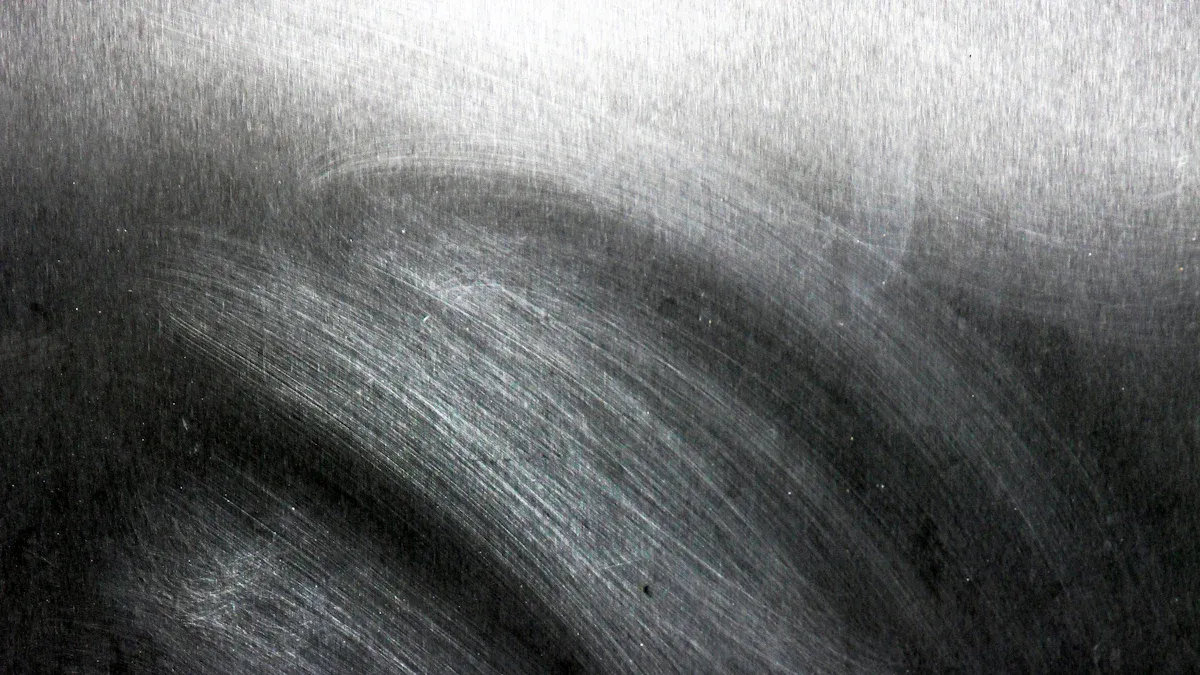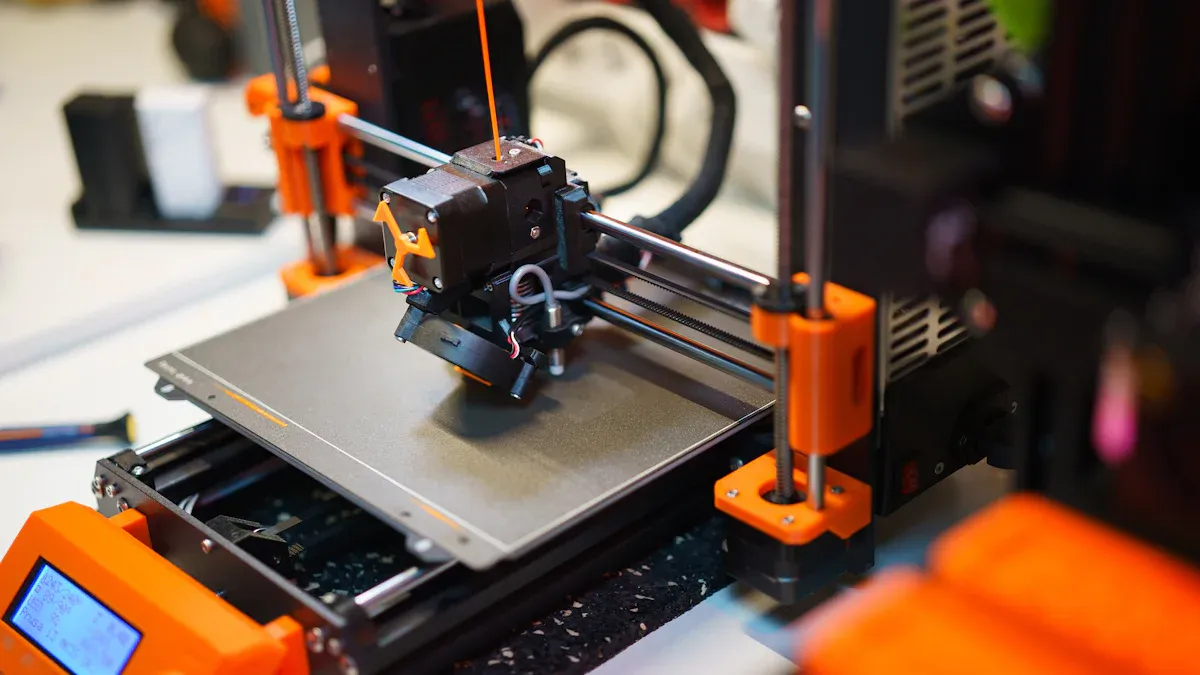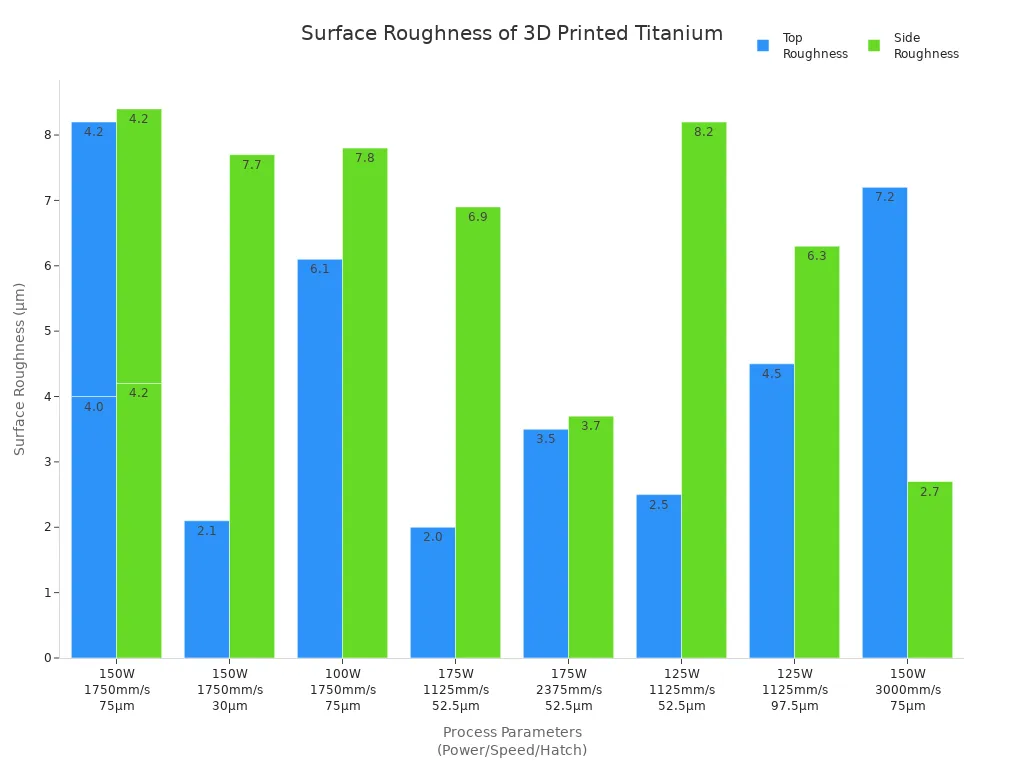
Surface quality significantly impacts the performance and longevity of titanium components. Engineers often prioritize this aspect to ensure reliability in critical applications. For instance, CNC-machined titanium typically exhibits a superior surface finish compared to its 3D printed counterpart. A recent analysis shows that 3D printed titanium parts have a surface roughness ranging from 7 to 23 µm, which can affect their functionality. In contrast, CNC-machined parts often achieve a much finer finish, leading to enhanced durability and performance in demanding environments.
Key Takeaways
- CNC-machined titanium parts have a superior surface finish compared to 3D printed parts, enhancing durability and performance.
- The CNC machining process allows for tight tolerances, achieving precision as small as ±0.005 mm, crucial for high-performance applications.
- 3D printing offers design flexibility, enabling the creation of complex geometries that traditional methods cannot achieve.
- Post-processing techniques like polishing and abrasive blasting are essential for improving the surface quality of 3D printed titanium parts.
- Surface quality directly impacts the performance and reliability of titanium components in critical applications like aerospace and medical devices.
- Engineers should consider specific project needs, such as precision and surface finish, when choosing between CNC machining and 3D printing.
- CNC machining typically requires less post-processing than 3D printing, making it a more efficient choice for high-quality parts.
- Understanding the material properties of titanium helps optimize machining and printing strategies for better surface quality.
CNC Machining Process

Overview of CNC Machining
CNC machining, or Computer Numerical Control machining, represents a highly precise manufacturing process. This method utilizes computer-controlled machines to remove material from a workpiece, shaping it into the desired form. The process involves several key steps:
- Semi-Finishing: This stage focuses on achieving closer tolerances and preparing the surface for final finishing. It requires careful speed control and minimal chip load.
- Finishing: During this phase, operators apply final touches using sharp tools and controlled heat. This step is crucial for achieving the desired surface finishes and demands high precision.
- Post-Machining Processes: After machining, parts undergo deburring, polishing, and inspection. Non-destructive testing is often necessary for aerospace or medical applications to ensure safety and quality.
Impact on Surface Quality
The CNC machining process significantly influences the surface quality of titanium components. Titanium’s unique properties, such as low thermal conductivity and high strength, present challenges during machining. The following table illustrates how titanium compares to other metals in terms of surface finish control:
| Metal | Thermal Conductivity | Tendency to Gall | Surface Finish Control |
|---|---|---|---|
| Titanium | Low | High | Requires careful control of cutting parameters and tool conditions |
| Steel | High | Low | Easier to achieve good surface finishes due to favorable properties |
Achieving a smooth surface finish in CNC machined titanium requires meticulous attention to cutting parameters. Factors such as feed rate, cutting speed, and tool wear play critical roles. For instance, the feed rate directly affects surface roughness. Additionally, tool wear can lead to increased energy consumption and negatively impact surface quality.
Material Properties and Their Effects
Titanium’s material properties significantly influence its machinability in CNC processes. The following table summarizes key properties and their effects:
| Property | Influence on Machinability |
|---|---|
| Strength | High strength can lead to tool wear and challenges in cutting. |
| Ductility | Good ductility can help in reducing vibrations during machining. |
| Thermal Conductivity | Low thermal conductivity leads to heat buildup, affecting tool life and cut quality. |
| Tool Wear | Different alloys affect wear rates, necessitating careful material selection. |
Machinists must also consider the microstructure of titanium alloys. Variations in alloy composition can lead to different surface roughness levels after machining. For example, titanium alloy Ti64 typically exhibits a surface roughness of 5.68 ± 0.44 µm, while Ti67 shows a finer finish at 4.52 ± 0.35 µm. Understanding these properties allows engineers to optimize machining strategies for better surface quality.
3D Printing Process

Overview of 3D Printing
3D printing, also known as additive manufacturing, involves creating objects layer by layer from a digital model. This process allows for the production of complex geometries that traditional manufacturing methods may struggle to achieve. Two primary technologies dominate the 3D printing landscape for titanium:
| Technology | Operation Description |
|---|---|
| DMLS (Direct Metal Laser Sintering) | Utilizes a high-power laser to fuse titanium powder layer by layer, allowing for complex geometries. Requires careful control of energy input to avoid defects. |
| EBM (Electron Beam Melting) | Uses a high-energy electron beam in a vacuum to melt titanium powder, preventing oxidation and allowing for precise control over the melting process. |
The Laser Powder Bed Fusion (LPBF) method is the most common technique for 3D printing titanium parts. It fuses powdered titanium layer by layer using a high-powered laser. This method is known for producing precise and durable components with complex geometries. Typical layer thicknesses range from 16 µm to 150 µm, depending on the printer’s capabilities.
Impact on Surface Quality
The surface quality of 3D printed titanium components varies significantly based on several factors, including geometry, printing orientation, and layer thickness. The root mean square deviation (Rq) of 3D-printed titanium components can differ widely. For instance:
- Rq values recorded were:
- 6.94% for dogbone tensile test specimens
- 8.16% for a 3.4-mm diameter dental implant
- 7.08% for a 4.3-mm diameter dental implant
The smaller and more complex the geometry of the 3D-printed component, the higher the Rq value, indicating increased surface roughness. Conversely, flat specimens yield better surface quality, with the lowest surface roughness (Sq) observed at 14.77%, compared to 52% and 53% for dental implants.
Post-processing techniques play a crucial role in enhancing the surface quality of 3D printed titanium parts. As-built surfaces often exhibit high roughness and porosity, necessitating treatments to meet performance standards. Common post-processing methods include:
- Abrasive blasting: High-speed abrasive particles remove surface roughness.
- Polishing: Achieves a smooth surface finish, either manually or automatically.
- Chemical etching: Immerses parts in a chemical solution to remove surface material.
- Machining: Ensures precise dimensions and tight tolerances using special cutting tools.
Material Properties and Their Effects
The material properties of titanium significantly influence the 3D printing process and the resulting surface quality. Key aspects include:
| Aspect | Effect on Surface Quality |
|---|---|
| Porosity | Leads to reduced fatigue strength, acting as sites for crack initiation. |
| Microstructure | Influences material response to stress and overall performance, affecting mechanical properties. |
| Surface Topography | Rough surfaces can contribute to fatigue crack nucleation, necessitating treatments to improve surface quality. |
Optimizing printing parameters, such as layer thickness and laser settings, is essential for achieving smoother surfaces. Thinner layers generally lead to improved surface finish and mechanical performance. Additionally, careful calibration of laser parameters balances speed and quality, ensuring that the final product meets stringent engineering standards.

Comparative Analysis
Advantages of CNC-Machined Parts
CNC-machined titanium parts offer several advantages that make them suitable for high-performance applications. Key benefits include:
- Superior Surface Finish: CNC machining achieves a surface finish of Ra1.6 or better, which often requires minimal post-processing. This high-quality finish enhances the durability and performance of the components.
- Tight Tolerances: CNC machining can achieve tolerances as tight as ±0.005 mm. This precision is crucial in industries such as aerospace and medical, where exact specifications are vital.
- Minimal Surface Defects: The continuous material removal process in CNC machining results in fewer surface defects. Operators can maintain high precision with little to no post-processing requirements.
| Manufacturing Method | Surface Finish (Ra) | Post-Processing Needs |
|---|---|---|
| CNC Machined | Ra1.6 or better | Minimal |
| 3D Printed (SLM) | Ra7 | Often required |
Advantages of 3D Printed Parts
3D printed titanium parts also present unique advantages, particularly in design flexibility and production efficiency. Notable benefits include:
- Complex Geometries: 3D printing allows for the creation of intricate designs that traditional methods cannot achieve. This capability enables engineers to optimize performance while reducing weight.
- Internal Structures: The technology supports the incorporation of internal lattice structures, which enhance strength without adding significant weight. This feature is particularly beneficial for applications requiring lightweight components.
- Rapid Prototyping: 3D printing facilitates quick iterations of design, allowing for faster development cycles. This speed can significantly reduce time-to-market for new products.
Disadvantages of CNC-Machined Parts
Despite their advantages, CNC-machined titanium parts have some limitations. These include:
- Thermal Expansion Issues: Thermal expansion during machining can lead to dimensional inconsistencies. Operators must account for this factor to ensure precision.
- Material Discoloration: Heat-induced stresses can cause discoloration and degrade the material properties, impacting performance.
- Tool Wear: The stickiness of titanium can lead to tool wear and surface damage. This wear can create micro-grooves and scratches, affecting the final surface quality.
Disadvantages of 3D Printed Parts
3D printed titanium parts present several disadvantages that can impact their performance and usability in critical applications. Understanding these challenges is essential for engineers and manufacturers when selecting the appropriate production method.
- Surface Roughness: One of the primary issues with 3D printed titanium components is surface roughness. The layer-by-layer construction often leads to a stair-stepping effect on angled surfaces. This phenomenon can result in Ra values exceeding 25 µm, which negatively affects the surface finish. Powder particles may also adhere to the surfaces, further increasing roughness. To mitigate these issues, manufacturers often need to employ careful build orientation and post-processing techniques, such as polishing or chemical smoothing.
- Anisotropic Mechanical Properties: 3D printed parts can exhibit anisotropic mechanical properties due to incomplete fusion between layers. This inconsistency particularly affects tensile strength in the Z-axis direction. Engineers must consider these variations when designing components for load-bearing applications, as they can compromise structural integrity.
- Residual Stresses: During the 3D printing process, residual stresses develop, significantly affecting the durability and performance of titanium components. The orientation and magnitude of these stresses can either enhance or detract from the material’s properties. While powder bed fusion methods yield parts closer to their final shape, they still exhibit rough surface finishes. Post-heat treatment can help reduce these residual stresses, but it adds complexity to the manufacturing process.
- Post-Processing Requirements: Most 3D printed titanium parts require extensive post-processing to achieve acceptable surface quality. This necessity can increase production time and costs. For instance, secondary machining may be essential for functional parts, especially in aerospace applications where isotropic mechanical properties are critical for load-bearing components.
- Cost Considerations: While 3D printing offers design flexibility, the trade-off often lies in the cost. Finer powder particles and reduced layer thicknesses can improve surface finish but at a higher expense. Manufacturers must balance the desire for superior surface quality with economic factors, which can complicate decision-making.
Choosing the Right Method
Factors to Consider
When selecting between CNC machining and 3D printing for titanium parts, several factors come into play. Engineers must evaluate the specific requirements of their projects to make informed decisions. Key considerations include:
- Precision and Surface Finish: CNC machining provides high precision and a professional finish, making it ideal for applications requiring tight tolerances. In contrast, 3D printing allows for more complex geometries but may need post-processing to improve surface quality.
- Mechanical Strength and Thermal Performance: CNC machining excels in applications where high mechanical strength and thermal performance are critical. It suits projects that demand tight dimensional tolerances and cost efficiency for small-to-medium production runs.
- Surface Characteristics: Parts produced through CNC machining may exhibit some surface roughness and blemishes, often described as ‘as-machined’ or ‘as-milled.’ Conversely, 3D printed parts can show surface roughness or graininess, with a potential stairstep appearance due to the layer-by-layer construction.
- Cost and Lead Time: The Kroll process for titanium is energy-intensive, leading to high production costs. Specialized equipment is necessary for machining titanium due to its hardness, which adds to overall costs. Long lead times in milling can delay projects and increase expenses.
In summary, CNC machined titanium parts generally offer superior surface quality compared to their 3D printed counterparts. CNC machining achieves finer finishes, tighter tolerances, and fewer surface defects. Conversely, 3D printing provides design flexibility but often results in higher surface roughness.
Engineers should consider specific project requirements when selecting a manufacturing method. For applications demanding high precision and durability, CNC machined parts are often the preferred choice.
FAQ
What is the main difference in surface quality between CNC machined and 3D printed titanium?
CNC machined titanium typically achieves a finer surface finish compared to 3D printed titanium. The machining process allows for tighter tolerances and fewer surface defects, enhancing overall durability and performance.
How does the machining process affect titanium’s surface finish?
The CNC machining process removes material precisely, allowing for controlled cutting parameters. This meticulous approach results in smoother surfaces, often achieving a finish of Ra1.6 or better, which is crucial for high-performance applications.
What are the common post-processing techniques for 3D printed titanium?
Common post-processing techniques for 3D printed titanium include abrasive blasting, polishing, chemical etching, and secondary machining. These methods help improve surface quality and achieve desired tolerances for functional parts.
Why is surface quality important in engineering applications?
Surface quality affects the performance, durability, and reliability of components. In critical applications, such as aerospace and medical devices, superior surface finishes reduce the risk of failure and enhance overall functionality.
Can 3D printed titanium parts achieve comparable surface quality to CNC machined parts?
While 3D printed titanium can achieve good surface quality, it often requires extensive post-processing to match the precision of CNC machined parts. Engineers must consider the specific application requirements when choosing a manufacturing method.
What factors influence the surface quality of 3D printed titanium?
Factors influencing the surface quality of 3D printed titanium include printing orientation, layer thickness, and material properties. Optimizing these parameters can help improve the final surface finish and mechanical performance.
Are there specific applications where CNC machining is preferred over 3D printing?
Yes, CNC machining is preferred in applications requiring tight tolerances, high surface quality, and minimal defects. Industries such as aerospace and medical often favor CNC machining for critical components due to its precision and reliability.
What role does material porosity play in 3D printed titanium?
Material porosity in 3D printed titanium can lead to reduced fatigue strength and act as sites for crack initiation. Engineers must address porosity through careful design and post-processing to ensure component integrity.

